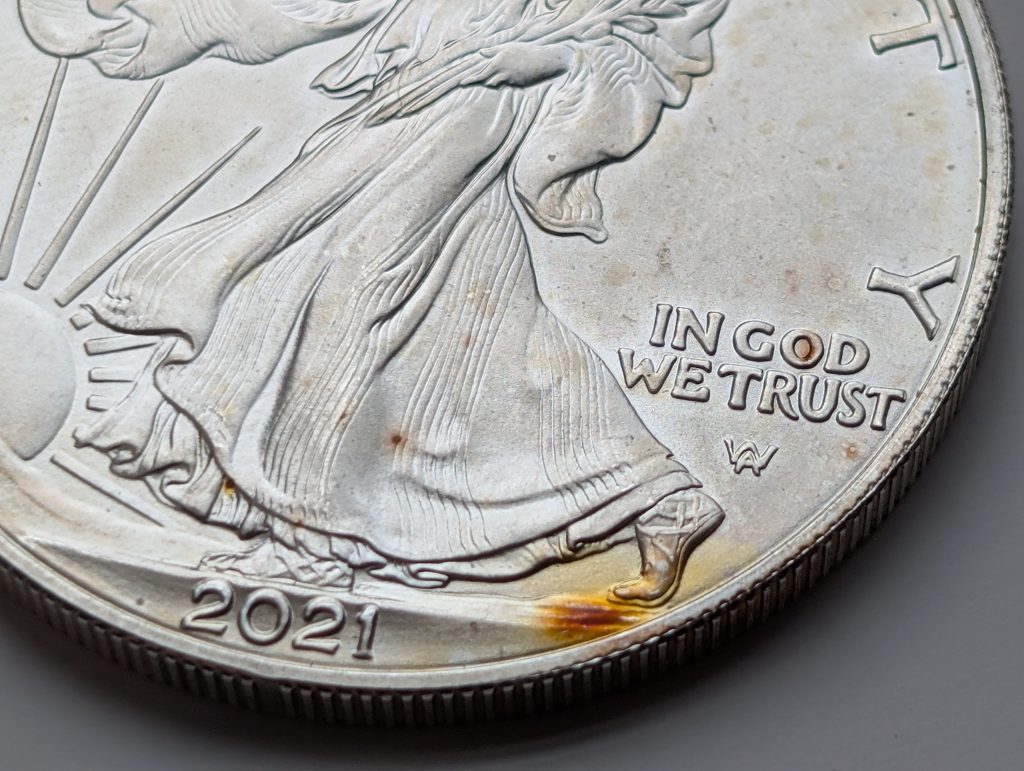What Is Tarnish? Understanding Natural Surface Changes in Coins
Not all discoloration on a coin is bad, but it’s not all good either. Tarnish is one of the most common surface changes collectors encounter, especially on silver coins. It’s the dull film that creeps across a coin’s surface over time, shifting its luster and tone without necessarily damaging the metal itself.
This post is about understanding that fine line: when tarnish is just a natural part of aging, and when it starts to signal something more serious. We’ll break down what causes tarnish, how it’s different from toning or corrosion, and what it means for collectors, dealers, and anyone trying to evaluate a coin’s condition honestly.
What Causes Tarnish on Coins?
Tarnish forms when a coin’s surface reacts with chemicals in its environment, most commonly sulfur, oxygen, and moisture. Silver is especially reactive to airborne sulfur compounds, which are present in things like paper, wool, rubber bands, even the air in some older storage boxes. Over time, these elements form a thin layer of silver sulfide on the coin, which dulls the shine and shifts the color.
Unlike corrosion, which actively eats away at a coin’s surface, tarnish is more passive. It usually doesn’t penetrate deeply and may even add a layer of protection if it remains stable. That said, the line between tarnish and the early stages of corrosion can get blurry, especially when moisture is involved.
Even coins made of copper, nickel, or other metals can tarnish, though the process looks different depending on the metal. Copper might go brown or darken unevenly. Nickel alloys tend to dull rather than shift color. Each metal has its own personality when it comes to reacting with the environment.
What Does Tarnish Look Like on Coins?

Tarnish isn’t one-size-fits-all. It shows up differently depending on the metal, how the coin was stored, and how long the reaction has been going on. On silver coins, tarnish often starts as a dull gray haze that can eventually deepen into brown, black, or splotchy dark spots. It tends to settle around the edges first, especially if the coin was exposed to air while sitting flat.
On copper-based coins, like Indian Head or Lincoln cents, tarnish usually appears as uneven darkening. The surface can lose its original red or red-brown color and shift toward a flat brown or gray-brown tone. In some cases, it might take on a blotchy or streaky look, especially on coins stored in PVC holders or low-grade flips.
Unlike toning, which often has vibrant or even rainbow-like coloration, tarnish tends to look muddy, flat, or lifeless. It can make details harder to see and diminish a coin’s visual appeal, especially if it spreads unevenly or becomes patchy. But not all tarnish is ugly or harmful. Sometimes, it gives a coin a mellow, antique look that collectors find charming in the right context.
Tarnish vs. Toning: What’s the Difference?
Tarnish and toning are both natural reactions that change the surface of a coin over time, and the line between them can get blurry. But there is a difference, and it matters.
Tarnish is usually seen as dull, patchy, or lifeless. It’s the result of chemical reactions with sulfur, oxygen, or moisture that leave the coin looking tired. Think brown smears on a silver half dollar, or a faded copper cent that used to glow red but now looks like old driftwood.
Toning, on the other hand, is what collectors hope to see. It’s the same kind of surface reaction (especially on silver) but the result is colorful and often even eye-catching. Blues, purples, and golds can appear naturally from careful storage, especially in old envelopes, albums, or paper rolls.
The difference often comes down to visual appeal. If it looks vibrant and smooth, it’s probably called toning. If it looks flat and unattractive, it gets called tarnish.
The reality? It’s a spectrum and sometimes one person’s toning is another person’s tarnish. But in the eyes of the market, tone tends to add value, while tarnish usually takes it away.
How Tarnish Affects Value
Tarnish usually hurts a coin’s value, but not always.
In most cases, tarnish is seen as damage. It dulls the luster, flattens the surfaces, and makes a coin look tired. For modern coins in particular, tarnish can mean an automatic drop in grade. A mint-state coin with dark, lifeless patches might technically be uncirculated, but its market value could fall well below what you’d expect.
That said, eye appeal matters more than the grade sometimes. If a tarnished coin still looks interesting, balanced, or unique, it can punch above its technical grade. Collectors don’t just buy numbers. They buy with their eyes.
This is especially true when tarnish overlaps with toning. Some coins walk the line between the two, and what one collector sees as unattractive, another might find beautiful.
The takeaway? Tarnish generally lowers a coin’s value, but the market isn’t always consistent. A coin with strong design detail, even color spread, or just the right lighting can still find a buyer. Sometimes at a premium.
Final Thoughts
Tarnish might sound like a bad word in coin collecting, but it’s not always a dealbreaker. Sometimes it’s ugly, sometimes it’s interesting, and sometimes it’s just the natural result of a coin existing in the real world. The key is being able to recognize it for what it is. Once you can spot tarnish, you’re in a better position to judge whether it adds character or subtracts value. Either way, it’s part of the story the coin is telling.
